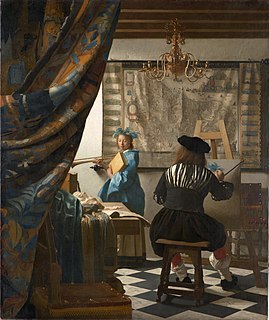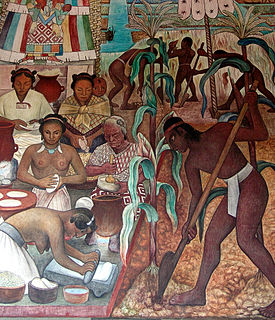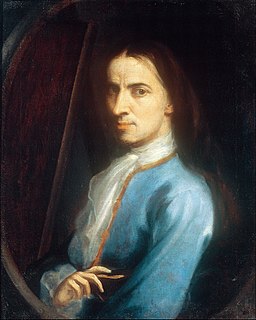
Juan Patricio Morlete Ruiz (San Miguel de Allende, 1713-1770, Mexico City) [1] was an 18th-century Mexican painter, a mestizo according to the system of racial classification. [2] He is most well known for his casta paintings.

Mestizo or mestiza is a term historically used in Spain, Spanish America and the Philippines that originally referred to a person of combined European and Indigenous American descent, regardless of where the person was born. The term was used as an ethnic/racial category for mixed-race castas that evolved during the Spanish Empire. Although broadly speaking, Mestizo means someone of mixed European/indigenous heritage, and usually for someone considered a plebeian, the term did not have a fixed meaning in the colonial period. It was a formal label for individuals in official documentation, such as censuses, parish registers, Inquisition trials, and other matters. Individuals were labeled by priests and royal officials as mestizos, but the term was also used for self identification.
Born in 1713 in San Miguel de Allende, he was a contemporary of Miguel Cabrera. Both artists were important to Casta painting and are accredited with many iconic elements of Casta painting that influenced the genre for decades after them. Like many artists in Colonial New Spain, he was a member of painting academy that was established in the mid-eighteenth century. [3] This status gave Morlete a place among the Spanish elite in Mexico. It is evident from documents at the time that both the Viceroy Carlos Francisco De Croix and Viceroy Antonio María de Bucareli y Ursúa commissioned work from him. [4]

San Miguel de Allende is the principal city in the municipality of San Miguel de Allende, located in the far eastern part of Guanajuato, Mexico. A part of the Bajío region, the city lies 274 km (170 mi) from Mexico City, 86 km (53 mi) from Querétaro, and 97 km (60 mi) from the state capital of Guanajuato. The city's name derives from two persons: 16th-century friar Juan de San Miguel, and a martyr of Mexican Independence, Ignacio Allende, who was born in a house facing the city's central plaza. San Miguel de Allende was also a critical epicenter during the historic Chichimeca War (1540–1590) where the Chichimeca Confederation defeated the Spanish Empire in the initial colonization war. Today, an old section of the town is part of a proclaimed World Heritage Site, attracting thousands of tourists and new residents from abroad every year.

The Viceroyalty of New Spain was an integral territorial entity of the Spanish Empire, established by Habsburg Spain during the Spanish colonization of the Americas. It covered a huge area that included territories in North America, South America, Asia and Oceania. It originated in 1521 after the fall of Tenochtitlan, the main event of the Spanish conquest, which did not properly end until much later, as its territory continued to grow to the north. It was officially created on 8 March 1535 as a Kingdom, the first of four viceroyalties Spain created in the Americas. Its first viceroy was Antonio de Mendoza y Pacheco, and the capital of the kingdom was Mexico City, established on the ancient Tenochtitlan.
A viceroy is an official who runs a country, colony, city, province, or sub-national state, in the name of and as the representative of the monarch of the territory. The term derives from the Latin prefix vice-, meaning "in the place of" and the French word roy, meaning "king". A viceroy's territory may be called a viceroyalty, though this term is not always applied. The adjective form is viceregal, less often viceroyal. The term vicereine is sometimes used to indicate a female viceroy suo jure, although viceroy can serve as a gender-neutral term. Vicereine is more commonly used to indicate a viceroy's wife.
Morete Ruiz’s paintings are significant to Mexican art history because Morlete Ruiz was one of the first artists to employ what would become standard elements of 18th century Casta painting. In his Casta sets, much could be determined about the status of the subjects based on their clothing, hair, and surroundings. His paintings featured the Spanish men as the dominant figures in the family. He also used body language to express attitudes and emotions that supposedly resulted from racial mixing.

A casta is a term which has been interpreted by historians during the 20th century to describe mixed-race individuals in Spanish America, resulting from unions of Spaniards (españoles), Amerindians (Indios), and Africans (Negros). Basic mixed-race categories that appeared in official colonial documentation include Mestizo, generally offspring of a Spaniard and an India; Castizo, offspring of a Spaniard and a Mestiza; Mulatto, offspring of a Spaniard and a Negra; Morisco was the offspring of a Spaniard and a Mulatta. There were a plethora of terms for mixed-race persons of indigenous and African ancestry, some of which appear in official documentation, but many do not.
Apart from Casta painting, Morlete Ruiz followed the trend of exoticism by painting local flora and fauna, especially fruits to show a Spanish audience the bounty of the New World. Color contrast, sharp detail, and positioning of the figures reflect the influence of Dutch and Flemish genre painting in his work. [5]

Genre painting, also called petit genre, depicts aspects of everyday life by portraying ordinary people engaged in common activities. One common definition of a genre scene is that it shows figures to whom no identity can be attached either individually or collectively—thus distinguishing petit genre from history paintings and portraits. A work would often be considered as a genre work even if it could be shown that the artist had used a known person—a member of his family, say—as a model. In this case it would depend on whether the work was likely to have been intended by the artist to be perceived as a portrait—sometimes a subjective question. The depictions can be realistic, imagined, or romanticized by the artist. Because of their familiar and frequently sentimental subject matter, genre paintings have often proven popular with the bourgeoisie, or middle class.
Some of Morlete Ruiz’s paintings can be seen today at the LA County Museum of Art and the Museo Nacional de Arte of Mexico City.

The Museo Nacional de Arte (MUNAL) is the Mexican national art museum, located in the historical center of Mexico City. The museum is housed in a neoclassical building at No. 8 Tacuba, Col. Centro, Mexico City. It includes a large collection representing the history of Mexican art from the mid-sixteenth century to the mid 20th century. It is recognizable by Manuel Tolsá's large equestrian statue of Charles IV of Spain, who was the monarch just before Mexico gained its independence. It was originally in the Zocalo but it was moved to several locations, not out of deference to the king but rather to conserve a piece of art, according to the plaque at the base. It arrived at its present location in 1979.

Mexico City, or the City of Mexico, is the capital of Mexico and the most populous city in North America. It is one of the most important cultural and financial centres in the Americas. It is located in the Valley of Mexico, a large valley in the high plateaus in the center of Mexico, at an altitude of 2,240 meters (7,350 ft). The city has 16 boroughs.













